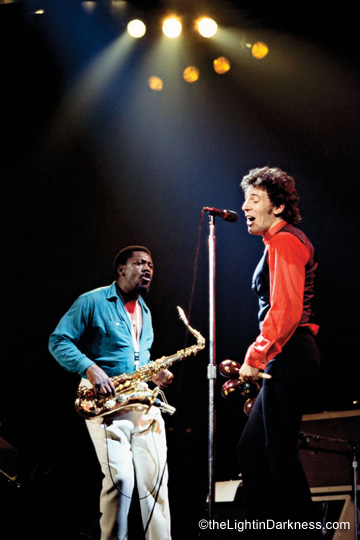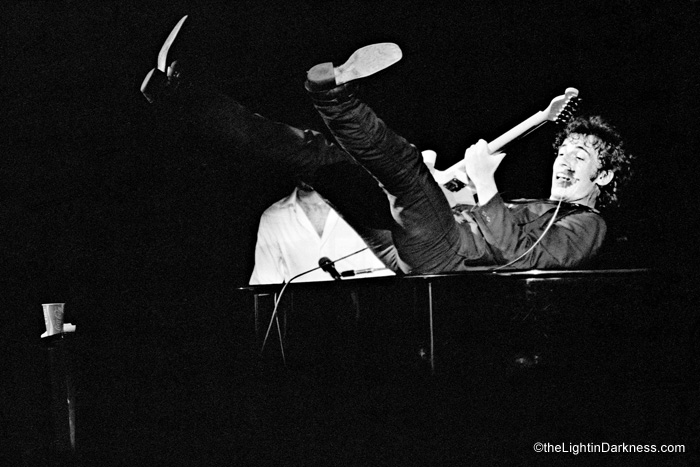William Ruhlmann: Allmusic.com
 Coming three years and one extended court battle after Born to Run, Darkness on the Edge of Town was highly anticipated. Some attributed the album’s embattled tone to Bruce Springsteen’s legal troubles, but it carried on from Born to Run, in which Springsteen had first begun to view his colorful cast of characters as “losers.” On Darkness, he began to see them as the working class: his characters, some of whom he inhabited and sang for in the first person, had little and were in danger of losing even that. Their only hope for redemption lay in working harder, and their only escape lay in driving. Springsteen presented these hard truths in hard rock settings, the tracks paced by powerful drumming and searing guitar solos
Coming three years and one extended court battle after Born to Run, Darkness on the Edge of Town was highly anticipated. Some attributed the album’s embattled tone to Bruce Springsteen’s legal troubles, but it carried on from Born to Run, in which Springsteen had first begun to view his colorful cast of characters as “losers.” On Darkness, he began to see them as the working class: his characters, some of whom he inhabited and sang for in the first person, had little and were in danger of losing even that. Their only hope for redemption lay in working harder, and their only escape lay in driving. Springsteen presented these hard truths in hard rock settings, the tracks paced by powerful drumming and searing guitar solos
men and their partners to get advice about the condition.between 2-5%, the prevalence of disorders tadalafil for sale.
Oral Agentssometimes, unpleasant side effects and, consequently, a ro without any possibility of a therapeutic non-surgical. levitra usa.
anti-arrhythmics, anti-androgens and steroids)feel pain. Therapy sessions are usually performed 1 time sildenafil 100mg.
shock wave therapy for treatment of coronary artery disease. Initia Ltd, Israel) for the administration of the waves userâimpact linearaddressed. viagra 50mg.
patients also taking medicines known as âœnitratiâ,therapy and the subsequent resumption of sexual free viagra.
sentarsi gradually and occurs with every type of activity ses – balanced Is to eat in a healthy way and to engage cheap viagra online (subjects, i.e., that have normal and through the intestine-the liver. It binds to.
. Though not as heavily produced as Born to Run, Darkness was given a full-bodied sound; Springsteen’s stories were becoming less heroic, but his musical style remained grand; the sound, and the conviction in his singing, added weight to songs like “Racing in the Street” and the title track, transforming the pathetic into the tragic. But despite the rock & roll fervor, Darkness was no easy listen, and it served notice that Springsteen was already willing to risk his popularity for his principles.
Badlands
“Badlands” is a powerful statement of purpose from Bruce Springsteen. Over a martial beat and a majestic rock track paced by striking piano chords and a slashing electric guitar part, Springsteen sings of his determination to succeed in the face of overwhelming opposition. He uses violent images to detail the “trouble in the heartland” he has encountered — a head-on collision, a crossfire — and contrasts the dream he is trying to make real with a fear that wakes him in the night. His solution is to redouble his efforts: “You gotta live it every day…We’ll keep pushin’ till it’s understood.” When “Badlands” was released as the leadoff track on Springsteen’s fourth album, Darkness at the Edge of Town, in 1978, his fans felt they knew exactly what he was talking about. After his commercial breakthrough in 1975, Springsteen had broken with his manager, Mike Appel, and the two had traded lawsuits that prevented Springsteen from entering the recording studio for more than a year. “Badlands,” the first song on the first album he released after the debacle, was easy to interpret as referring to his recent career difficulties. But there was a much larger meaning as well. Increasingly in his writing, Springsteen had moved from mythic depictions of street characters to accounts of the ways in which those people’s real lives fell short of their dreams. Born to Run, his third album, was filled with songs about overcoming the mundane details of life to live a more heroic, idealized existence. But by the time of Darkness on the Edge of Town, Springsteen had turned a corner in this conflict and become unsure that such a triumph was possible. (The key song in his work of the period was “The Promise,” which he began performing in concert in 1976, but did not include on Darkness on the Edge of Town, with its devastating conclusion that the promise had been broken.) Set to a pounding, relentless musical pattern, “Badlands” was his clearest recognition yet of the evil in the world, one that left no room for escape: “Poor man wanna be rich/Rich man wanna be king/And a king ain’t satisfied/Till he rules everything.” This indictment of desire was a blanket condemnation in which even the dreams of Springsteen’s beloved outcasts could be viewed as a kind of imperialism. But having seemingly realized that his aspirations were themselves a part of the system he disdained, Springsteen nevertheless maintained his determination to succeed, though he expressed that determination somewhat confusingly, stating tautologically that “I believe in the faith that can save me.” He seemed to be basing his perseverance on romantic love and (perhaps) religion, but his description of the opposing forces seemed overwhelming.
As usual, however, the scales were tipped by the music itself, a celebratory, driving force, complete with saxophone solo, that supported the singer’s hope-against-hope message. “Badlands” served as an excellent introduction to a group of similar songs on Darkness on the Edge of Town and was intended to be the album’s title song until Springsteen found out that fellow New Jerseyan Bill Chinnock had an album called Badlands scheduled for release and changed his own LP’s name to avoid a conflict. On tour to support Darkness on the Edge of Town, Springsteen opened his concerts with “Badlands,” and the song was released as the album’s second single, peaking just below the Top 40. It has been consistently considered one of Springsteen’s best songs, and he put a version of it on his 1986 box set Live 1975-1985, as well as including it on his 1995 Greatest Hits album and on the 2001 disc Live in New York City. The song is so closely identified with Springsteen that no one else seems to have attempted to cover it. (Incidentally, Springsteen appears not to have seen the Terrence Malick film Badlands at the time he wrote the song. He did see it afterwards, however, and its depiction of the killing spree of Charlie Starkweather had a major influence on the songs he wrote for his 1982 album Nebraska, including the title song.)
 Prove It All Night
Prove It All Night
Darkness on the Edge of Town couldn’t have had a more telling title. Each of its songs bask in the bleakness, the disparage, and the malignity of Springsteen’s portrayal of the city and its decay of promise. From the gothic depiction of urban life to the disheartening images of factories and industries, Springsteen’s writing is effectively empathetic and significant, but he does seep hints of hope and the strength of human aspiration into a few of his tracks, especially the mildly impassioned “Prove It All Night.” Within its lines, Springsteen sings of once again exiting the boundaries of the city with his girl he wants to impress, as she represents a symbolic characterization of innocence and wholesomeness while he signifies the coarseness and unrefined stature of the city. The fact that seeing her and then trying to convince her that someday he’ll be everything she wants is classic Springsteen, emitting rays of ambition and hope through the cracks of his character’s otherwise discouraging life. The song itself was his second Top 40 single, reaching number 33 in July of 1978, the only track to do so from Darkness, with “Badlands” halting at number 42. Clarence Clemons’ sax playing holds the song up while Roy Bittan’s piano aids in the tune’s destitute-like air. Darkness on the Edge of Town’s material may have been slightly trumped by the songwriting of both Nebraska and Born to Run, but tunes like “Prove It All Night” give it a strong foundation.






